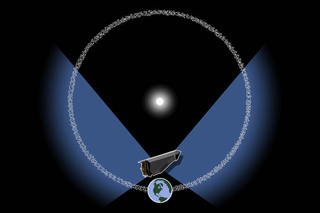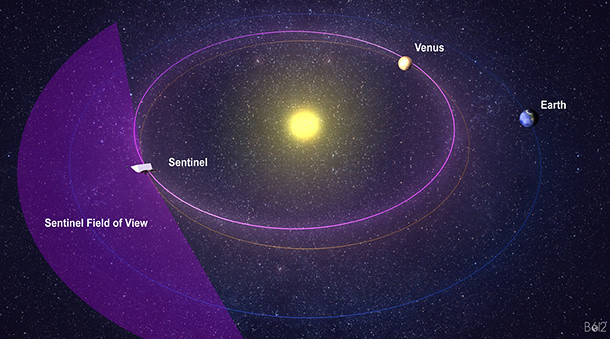Create a free profile to get unlimited access to exclusive videos, sweepstakes, and more!
Privately and publicly looking for Earth-threatening asteroids

[Note: In the interest of full disclosure, I am friends with many of the folks on both teams described below. I have tried to be scrupulously fair to both missions, and to be honest - as I say below - the best thing to happen would be for both missions to be locked, loaded, and looking for potentially hazardous rocks.]
![]() The B612 Foundation is a group of scientists, astronauts, astronomers, and engineers who have come together to do nothing less than literally save the world: they want to find and deflect asteroids that can potentially hit the Earth. While really big asteroids are rare -- after all, the one 10 km (6 miles) across that wiped out the dinosaurs only hits Earth every few hundred million years -- smaller ones in the 100 meter range are far more common and can still do devastating damage. Even one just 50 meters across (smaller than a football field) can impact and explode with the yield of millions of tons of TNT. That's in the range of the biggest nuclear weapons ever detonated.
The B612 Foundation is a group of scientists, astronauts, astronomers, and engineers who have come together to do nothing less than literally save the world: they want to find and deflect asteroids that can potentially hit the Earth. While really big asteroids are rare -- after all, the one 10 km (6 miles) across that wiped out the dinosaurs only hits Earth every few hundred million years -- smaller ones in the 100 meter range are far more common and can still do devastating damage. Even one just 50 meters across (smaller than a football field) can impact and explode with the yield of millions of tons of TNT. That's in the range of the biggest nuclear weapons ever detonated.
Finding these asteroids is notoriously difficult. They're small and dim, and sometimes only discovered once they've already passed us! The best way to find them in large numbers is to launch a space telescope to survey the sky, tuned to the infrared where these asteroids are far brighter and easier to spot.
Today, B612 made a big announcement: they want to build just such a mission. They call it Sentinel, and it will be the first privately funded deep space mission ever launched. Built by Ball Aerospace and launched on a SpaceX Falcon 9 rocket, it will be placed into a Venus-like orbit, giving it a good view of the volume of space where these asteroids prowl:
[Click to chixchulubenate.]
The plan is to raise the money philanthropically, like museums do: donations from private funders. Observatories have long been funded this way, and the proposed cost of a few hundred million dollars is roughly on par with many civic projects. Their target launch date is 2017 to 2018, and the mission will last about 5 years.
 Interestingly, a group of scientists and engineers with NASA/JPL is planning a similar mission! Called NEOCam (for Near Earth Object Camera), it's based on previous missions like WISE and Hubble.
Interestingly, a group of scientists and engineers with NASA/JPL is planning a similar mission! Called NEOCam (for Near Earth Object Camera), it's based on previous missions like WISE and Hubble.
Sentinel and NEOCam have many similarities: they both use a 50 cm or so telescope, both are tuned to infrared, and both will launch into orbit to get a better view of potentially threatening asteroids. Unlike Sentinel, NEOCam will stick closer to the Earth, placed into an orbit that keeps it about a million miles away. The advantage of this is that being closer, the rate at which data can be sent to Earth is very high. That allows more and higher-resolution observations to be made. While Sentinel is designed to look at one broad region of the infrared spectrum, NEOCam will look in multiple wavelengths, giving it the ability to characterize the size and chemical composition of asteroids more accurately.
This part is important: the two missions do two different things! Sentinel is designed to find and get accurate positions and orbits for these asteroids. NEOCam will also find lots of asteroids, but is optimized for science, to understand the asteroids' physical characteristics. Both of these factors are critical and complementary. We need both.
The missions also look at different parts of the sky, so that means more coverage of space. That's very important too: those rocks are out there. There are thousands of near-Earth asteroids bigger than 100 meters across, and millions in the 30 - 50 meter range. We've only found a fraction of these rocks, and so the critical first step is to simply find them and figure out their orbits. Both NEOCam and Sentinel will do this, including ones that are very difficult to observe from the Earth.
At some level these missions are in competition, since NASA is involved with both. However, since Sentinel is privately funded and NEOCam the result of NASA funding, I think it's entirely possible -- even preferable -- that both of these missions are built! The more eyes we have on the sky the better. Not only that, but missions that do different observations, as these do, are necessary as well.
The threat from asteroid impacts is real. We have to be careful not to get hysterical (every time I report on some near miss a lot of people get really scared -- but you have to remember the point is that they missed!), and instead look at this threat rationally. The reason you've heard more about near-Earth asteroids recently is that we're getting better at detecting them. These missions will increase hugely our ability to find hazardous asteroids. And once we find them, we can take that next all-important step: moving them out of the way.
But first things first. Launch both these birds!
Image credits: ESA/Rosetta, NASA/NEAR; B612 Foundation; NASA/JPL
Related Posts:
- My asteroid impact talk is now on TED
- Asteroid 2011 AG5: a football-stadium-sized rock to watch carefully
- A brief bit about asteroid 2012 DA14















